Simon Beaufils speaks about image and the directing of "Anatomy of a Fall", de Justine Triet
"Sun, snow, and a criminal court", by François ReumontSandra, Samuel and their visually impaired 11-year-old son Daniel have been living in the mountains for a year, away from everything. One day, Samuel is found dead at the foot of their house. An investigation begins around the suspicious death. Sandra is soon charged, although there is some doubt as to whether it was suicide or homicide. A year later, Daniel attends his mother’s trial, a true dissection of the couple.
This is your third film with Justine Triet. How did she introduce you to this new project ?
Simon Beaufils : After Sybil, Justine told me that she wanted to change her style and the tone of her images. She works a lot between shoots, watching a lot of films, preparing her new projects well in advance. For Anatomy of a Fall (Anatomie d’une chute), she wanted a much rougher, contrasted image, with intentional ’mistakes’... and a slightly chaotic visual. No spotlights on set, and only daylight, coming in from the windows, giving the actors a lot of freedom. It was the opposite of the soft, enveloping atmosphere, closer to studio lighting that we’d used on Sybil. The project also had a very particular rhythm. There was a long section devoted to the trial and, above all, the ending, giving the viewer freedom to interpret the situation. When I first saw it, I thought it had a very John Cassavetes feel to it, with these various layers being peeled back, revealing the complexity of the characters as the film progresses.
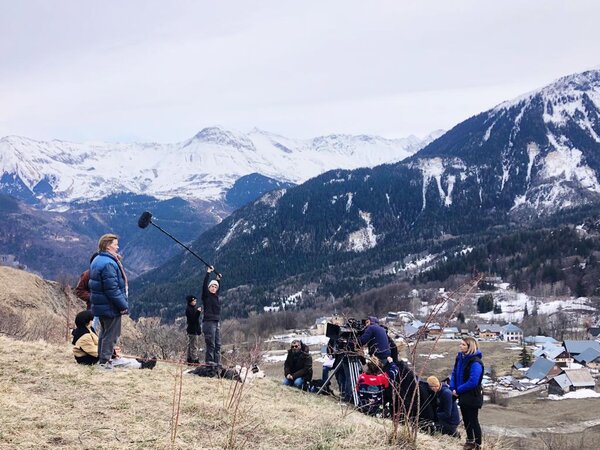
The film opens in high altitude, in the middle of the snow, in a chalet overlooking the mountains...
SB : Choosing the chalet was complicated. There were two conditions dictated by the script : a facade that would be high enough to accommodate the fall, and a residence that wouldn’t be too luxurious, given the couple’s financial problems. We visited a lot of them before finally choosing this one, which was really high up (and not easy to get to in snowy weather) but whose view seemed to be conducive to the plot. Indeed, such a location at the bottom of a valley, or tucked away in the forest, would have given a rather depressing or ’horror film’ connotation right from the start. Setting the first scenes in the sunshine, at high altitude, with the snow and the postcard-perfect scenery, seemed to give the perfect counterpoint. To follow Justine’s request for this specific working method, I had to bring a very large cherry picker to the location so that I could set up my light sources. The challenge was to light all three floors of the chalet at the same time, so that we could quickly alternate scenes on the ground floor, upstairs with the bedrooms, or in the attic.
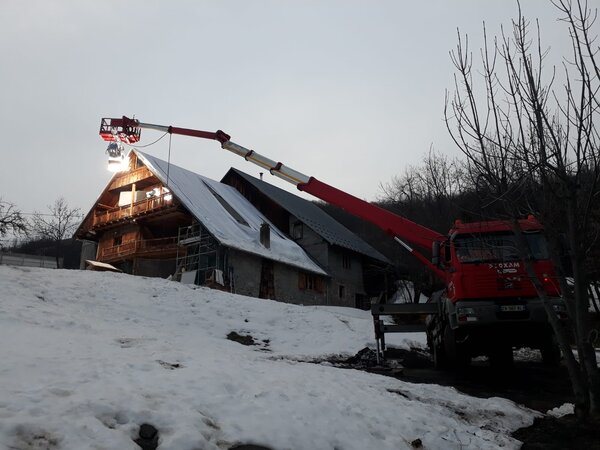
To do this I used a combination of Ruby 7 and 18kW Arrimax on the platform. The sun effects were provided by the Ruby 7s, supplemented by Aircrafts on the ground, with the Arrimax and M90s used to balance the indoor/outdoor level. In the end, my smallest light source on the film was an M40, which, given the sun and the reflection of the snow, was essential. But such a cherry picker, at this altitude in snowy conditions, caused some worry on set : choosing the right platform model with Léo and Sophie, getting financial validation by Julien, the production manager, adding to that the set design and meticulous organisation by the location management... I have to say that I was quite happy - even relieved ! - when it all finally came together...
The other setting is, of course, the courtroom, which takes over in the second half of the film...
SB : There aren’t many courthouses available for cinema. And once you’ve found the right one, you can’t use it for very long. For Anatomy, we shot in Saintes, in the Charentes Maritimes. We were given eight days. Of course, that was a very short time to film the 1 hour 40 minutes we’d planned in the script ! We had to shoot with two cameras at all times, with a fairly substantial lighting installation to make sure we had the correct match, while adapting the lighting and moods to the different parts of the trial. The windows in the courtroom were very high, and we couldn’t use cranes outside (the courtroom being nested around other buildings that weren’t as high). So the crew had to build an artificial floor over the glass roofs to be able to install the sources on stands. M90s were mainly used through diffusion frames, with Aircraft tungsten, mixing the proportions in order to change the colour temperature. Especially in the scenes at the end of the trial, which have an ’end of the day’ feel, warmer, and with higher contrast.
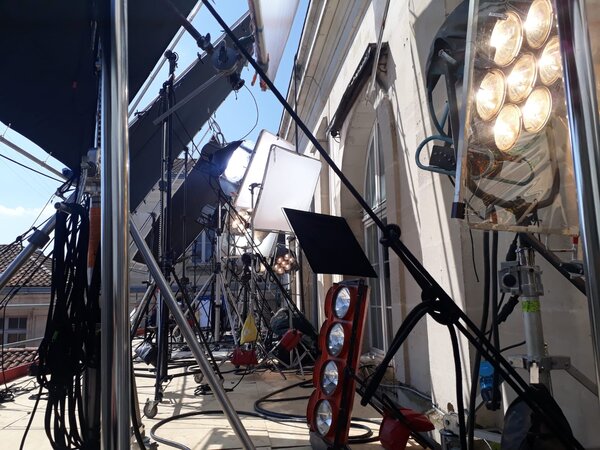
Justine and I wanted to create a carnal tone, with reddened skin, sweat and fatigue. The trial being very long in the film, we wanted the light to evolve, so that we would feel the duration, the passage of time and the couple’s autopsy, revealing more and more intimacy.
The wood panelling gave the place a very solemn feel. With Emmanuelle, the designer, we decided to break this continuity, creating contrast by inserting green coats of arms into the walls, just like on the fresco above the judge.
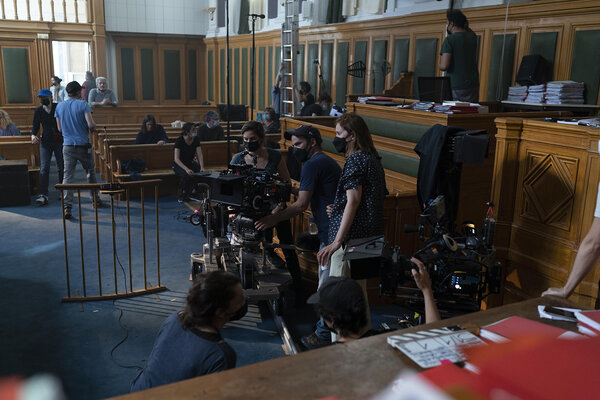

What were the requirements or references in terms of image ?
SB : Just as with the lighting, Justine wanted an image that was very different from what we’d done together in the past. She felt that this film needed to be more raw, with emphasis on the faces and the rendering of the skin, which was the basis of our work on this film, from prep to colour grading. Basically, she wanted to shoot film. In terms of production, the two cameras used for the court scenes were blowing the film/lab budget...so we decided to tests with 35mm 2perfs, Alexa Mini LF and RED Monstro, to try and get the digital cameras as close as possible to 35mm.
Did you then emulate this rendering during colour grading ?
SB : Not really... I decided to do as much as possible directly on set. That’s why I chose Hawk V-Lite lenses, which are anamorphic lenses, even though the film ratio was 1.85. But the V-Lite provided a softness, a richness of colour, very pronounced flares and special blurs which would cut the digital sharpness... And as these lenses don’t cover large format, we zoomed in quite a bit on the sensor, to give more substance, a sort of natural grain. This image reinforced our choice of the Alexa. Then, with Magali, for the colour-grading, we tried to go deeper, adding grain, working on the highlights, saturating the blues until we found a fairly pronounced LUT, that we used directly on the rushes. All this was done in quite a few stages, in a fairly empirical way, always trying to prioritize this relationship with the bodies and faces. Keeping things close, tangible, moving, alive.
In the chalet, the actors seem to be working against the light quite often, and there’s a lot of flare.
SB : Yes, V-Lite are very sensitive to flare ! Honestly, at times, I thought the flare was really strong, almost too strong... bearing in mind that it couldn’t be changed in post-production, and was almost hiding the actors’ faces. But Justine liked it and encouraged me to go further with the effects, even in post-production.
Zooms were also used quite a lot...
SB : Yes, I really like zoom movements. I think it’s a very useful staging tool, as much as the dolly or the crane. This trend, which had completely fallen out of fashion, is making a bit of a comeback in films. On Anatomie, we used an Angénieux Optimo 24-290 zoom lens with an anamorphic rear block. Admittedly, the rendering isn’t exactly the same as the Hawk prime lenses with front squeez, but it’s pretty good and it allowed us to shoot with a great deal of freedom, especially during the courthouse sequences. With an A camera installed on a VarioJib, on a dolly, I could frame whatever I wanted during the shoot. Justine even decided to edit some of the reframing shots or moves (during Sandra’s son Daniel’s deposition for example). Even in other, more intimate scenes, such as the night-time discussion between Sandra and her lawyer after the verdict (lit by car headlights), I still used this set-up, which allowed me to film the scene in several long, single takes (this time using a prime lens). The edit then alternated between these. Justine often asked the actors or the camera to give her extra variations, depending on what had inspired us at the end of a scene, even when she’d been pleased with the shot.
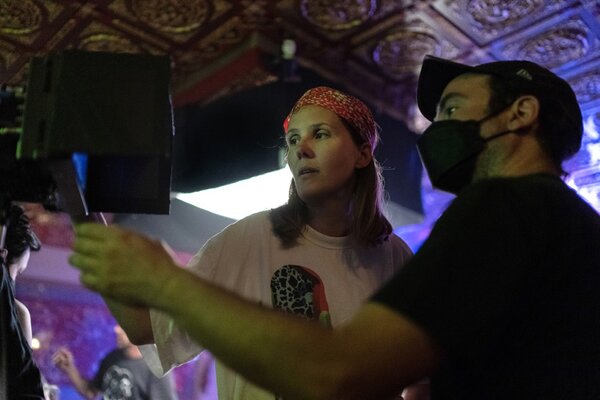
The camera seemed to float a little at times... it was quite discreet.
SB : Most of the time, during the pre-production cut, when we were planning a tracking shot, a crane movement or a Steadicam shot, that movement had a meaning, a significance. It would be in response to an idea from the direction, or to follow an evolution in the characters. I’m quite fascinated by camera moves that don’t necessarily make sense. Movements that are not dictated by an obvious need in the scene. However, these moves often give more resonance to a film. For example, in Bong Joon Ho’s film Mother, there was no reason for the crane movement in the first shot. A still shot would have done just as well ! And yet this shot, made up of little back and forth movements as if the camera didn’t quite know where to go, resonates throughout the film. There was no reason to do it, but it became central ; representing the sheer madness of this lost mother, capable of anything to help her child.
In Justine’s film, the mix of zoom, Vario rig, dolly and low-angle shots were intended to represent how, with hesitation, Sandra and her son were forced to face this legal beast. Sandra had to put unspeakable emotions into words. The lawyers’ task was to make a complex situation crystal clear, at the risk of distorting and oversimplifying it. Our task was to convey the extent to which human relationships are subtle, complicated, beautiful or cruel, in every way, complex.
At times, you also mix how things are filmed, within the film... through TV or the law...
SB : We wanted to mix public and private affairs. When everything is suddenly unleashed through the media... With the police, too, using a simple video camera to document the first interrogations or the reconstitution...
To do this, we simply choose a ten-year-old video camera to create a bit of an effect. A lot of news channels now ask their journalists to film with mobile phones, but we wanted to move away from that and offer an image with a little more ’video’ flavour. A mix that would be both obvious and discreet enough, without taking the viewer into a completely different film.

Interior night scenes are fairly rare, but you use one as a contrast with the rest, particularly at the end of the film.
SB : The trial reveals all the family’s intimacy. Those last moments at night, on the other hand, show solitude and anguish. The mother and child are reunited ; she then falls asleep on the sofa, where her husband used to sleep. Here, we chose a very blue atmosphere, with effects leaning towards a Spielberg-style image. The kind of atmosphere one feels when waking up from a nightmare, not quite sure what was real and what was a dream... A surreal night, conducive to the possibility of forgetting everything that happened. Even if nothing is stated, there is a calming quality to this image. What has really happened here ? Is Sandra guilty or innocent, beyond the court’s verdict ? One thing is certain, as Sandra says in the previous scene with her lawyer : this is a victory without a reward. Her only comfort is to have found her son.
Didn’t the idea of a two hours and a half film scare you ?
SB : In a time when we are asked to have an immediate point of view on everything, – in other words, to be ’for or against’ – , Anatomy of a Fall offers exactly the opposite. A complex study of relationships within couples, between spouses, and between parents and children... The law rules, puts in boxes, and asserts truths. Justine shows us what’s happening and suggests ways forward. The film doesn’t summarise the issue ; in fact, I think it opens up a number of avenues so that everyone can make up their own mind. I like the freedom the viewer has to wander around, taking in what they want - or need. Telling a story like this in 2.5 hours means you have to let yourself be swept in by the characters, and are ready to spend that time in a room, being told a story. It’s not about the sheer efficiency of storytelling... it’s more about the emotion, the way you feel about this woman and child.
(Interview conducted by François Reumont and translated from French by Chloé Finch, for the AFC.)
Anatomie d’une chute
Director : Justine Triet
Screenplay : Justine Triet, Arthur Harari
DoP : Simon Beaufils
Production Designer : Emmanuelle Duplay
Costumes : Isabelle Pannetier
Sound : Julien Sicart
Editing : Laurent Sénéchal
 En
En Fr
Fr





